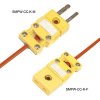woodmanrog
I love flying!
- Joined
- Oct 16, 2012
- Messages
- 25
For those who haven't already discovered it yet. I had erroneous engine temp readings pop up after about 65 hrs. of flying our new RV14A. The number 1 cylinder was fluctuating from 100 to 495 degrees, spinning like a top. Numbers 3 and 4 started out OK but then went to reading 100 degrees lower than they did one minute before. Here was the cure: All we did was trace the sender wires back to the spade connections inside the engine compartment. We disconnected and then reconnected each wire three or four times. All readings went back to normal. I guess a little vibration/moisture/corrosion took place and was eliminated by this process. I love simple fixes. 

